Ventilation Guide
Click here for latest 2021 Guide
Ventilation Guide an Introduction to Bathroom fans, Kitchen Fans & Cooker Hoods.
The quick guide of how to find a BATHROOM or KITCHEN fan that is perfect for you, your home and your family.
Many of the things we do on a daily basis create moisture – bathing, showering, laundry, cooking and boiling the kettle. These can all add up to a surprising ten litres of water being released into your home every day. Unless your home has good ventilation, this air can stagnate and cause poor air quality.
In order to prevent this it is important to understand the principles of good ventilation and this guide is intended to give a quick overview of what to consider and how to find a fan that is right for you.
The options for ventilation are many and varied so below we look at the basics. Get these right and the details will start to look after themselves.
However, before you read on, if you want to shorten the process here are two quick options:
1. The summary sheet below gives a brief visual overview of the features relating to each fan. If you would like an interactive version of this, visit the Epicair website and Click on the ‘Feature’ description for more information of the benefits these give or click on the image and you will be shown further details of each model.
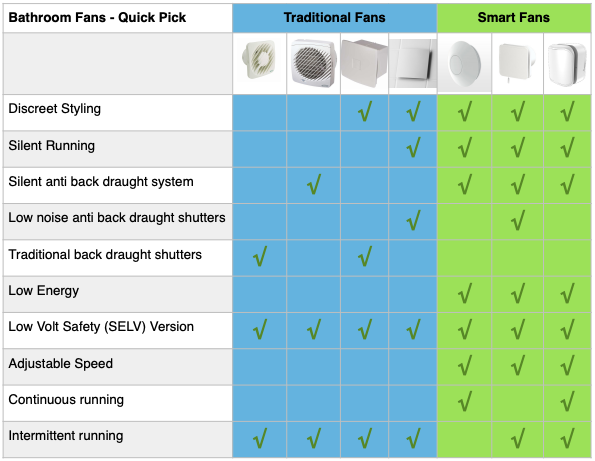
* Traditional Fans – standard AC motors and analog controls. Smart Fans Low Energy DC motors and digital controls
2. Bathroom Fan:
The Top 5 Bathroom Ventilation Considerations
1. What’s the location (Bathroom Safety Zones)
2. Where will it be installed (wall/ceiling/window)
3. How do you want to control the fan (Pull cord or automatic timer or humidistat)
4. Installing the fan (what to watch for)
5. The things that make a difference – shutters, running speed, Energy use intermittent vs continuous running, appearances – looks count
1. Bathroom safety
Electrical Safety A great deal of design and testing has gone into our Extractor Fans to ensure they are safe to use in wet environments such as Bathrooms. And because ‘wet areas’ such as bathrooms are considered to expose the occupant to an increased risk of electrical shock, special consideration is given to the safety of products installed in them. Your electrical contractor should be aware of the latest wiring and building regulations,
Further regulatory protection is offered by dividing the bathroom into zones which highlight how close the user, water and electrical supply are in proximity to each other. Products are then tested for water ingress and electrical safety and given an IP rating.
The IP rating is related back to a zone in the bathroom for which it is safe to be fitted. The diagram below shows how the zones work in practice;
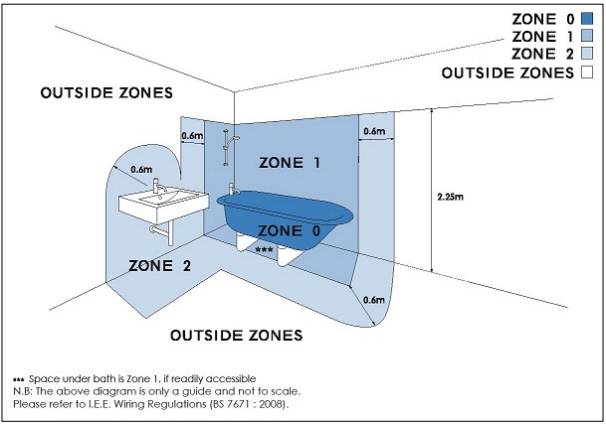
IP zoning
* Zone 0 - Inside the bath or shower. Any fittings used here must be SELV(Separated Extra Low Voltage - max. 12Volts) and have a minimum rating of IPX7(IP67) (protected against immersion in water - total immersion proof);
* Zone 1 - Above the bath or shower to a height of 2.25m. A minimum rating of IPX4(IP44) is required. In this zone, if there is likelihood of water jets being used for cleaning purposes, a minimum of IPX5 is required. Also, subject to IP rating, SELV may be used in this zone.
* Zone 2 - The area stretching to 0.6m outside the bath or shower and above the bath or shower if over 2.25m. An IP rating of at least IPX4(IP44) is required. In this zone, if there is likelihood of water jets being used for cleaning purposes, a minimum of IPX5 is required.
2. Fan location
Siting your Fan - In order to maximise the effectiveness of your fan, there are a few things you should consider. It needs to be as close as possible to the source of the steam but as far away as possible from the source of replacement air. The diagram below shows 'Poor Circulation' (red broken arrow) and 'Best Circulation' (red solid arrow). The 'Poor Circulation' diagram shows the fan next to an open window with the fresh air being extracted without taking the moisture laden air (from the bath) with it.

There is one further point regarding location and replacement air. Building Regulations recommend that there is a gap of 10mm between the bottom of the door and the top of the floor covering (i.e. Carpet or vinyl). This is in order to allow the flow of replacement air as otherwise, if the air flow is restricted, the performance of the fan will be reduced.
Internal Bathrooms, En Suites, Toilets, Wet Rooms, Basements, Cellars and Pooch Parlours
These areas need to be given special consideration, as they may not have any form of natural ventilation. A standard intermittent fan may not be sufficient in these environments as there are often insufficient air changes to prevent the buildup of stale air and moisture which, if it isn’t cleared, can create long term damage to your property in addition to making its way into clothes, carpets, and bed linen. One way to conquer these problems is to use a fan that runs continuously. Please click the link for information further information regarding continuous running fans.
3.Fan control options
The main control options are manual on/off, timer on/off or humidity sensing on/off controls
Operation and Controls
Operation and controls refers to how a fan is switched on or off and also depending on the model how it changes from slow to high speed. This is important as not only will it affect the performance of the fan but also how it works at keeping the air fresh. Below lists the most common forms of fan controls.
Basic - generally wired in with the light switch and simply turn on and off as the light is operated.
Timer - these are normally switched ‘on’ at the same time as the light is activated. After the light is turned ‘off’, the fan continues to run for an adjustable period - usually about twenty minutes - but with most models this can be set to anywhere between two and thirty minutes. The benefit is that the fan will continue to operate when the room is no longer in use, continuing to clear the moisture. There are also newer digital timer controls which provide greater accuracy and do not need adjustment*.
Humidistat - Humidstat fans have a sensor in them which absorbs moisture from the air stream of the fan. The sensor detects when moisture levels rise to a set level and at this point the fan is either switched ‘on’ or to higher ‘boost’ speed. There are also newer digital timer controls which provide greater accuracy and do not need adjustment*.
Continuous - this type of fan runs continuously at low- speed and then has a boost speed which generally operates when the room is in use or humidity levels rise. This form of ventilation is increasingly popular amongst new build housing and is advised in the Building
Regulations for rooms which have all internal walls with no windows. It is found that in this situation the ability to continually change the air at a low level is beneficial for enclosed rooms and helps prevent the buildup of mould and musty smells caused by poor air circulation.
*Fans with Smart controls can be found at the Low Energy section of the Epicair website
4.Installing your new fan
Wall or window fans will have short duct runs so providing the right accessories have been obtained, and the installation instructions followed, should provide an effective and properly functioning installation. One of the main areas requiring further consideration is that of ceiling installations with 3 key points:
1) Length of duct run up to 3 metres – if your duct run is longer than 3 metres consider using a centrifugal or mixed flow impeller fan which are designed for this situation.
2) Insulated ducting - as moisture laden hot air passes through a cold space condensation is likely to build and may leak (especially in Winter) causing stains on the ceiling below. Insulated ducting will help prevent this.
3) Keeping the duct work tight with as few twists and turns as possible to ensure the air flow is unimpeded. (See the diagrams below for reference)

In summary, if you are installing a ceiling fan or shower kit (where you have a fan mounted in your loft with ducting running either side), it's best to keep things as simple and as short as possible. The more kinks and twists in the ducting, and the longer the ducting, the less efficient the airflow will be. The two diagrams A & B are examples of a good installation and on the right C and bad one.
5.Details that make the difference
General Fan Selection Issues
There are many differing types of ventilation each designed to perform a specific task. Take a look at the list below and see if there is a particular issue which is important to you If one or two are, click on the link and you will be given some more information on each subject
- NOISE If a noisy fan is an issue, then this is for you - Silent
What is Silence?
By definition, silence is when a noise or sound is inaudible to the human ear. Generally, due to new technologies emerging, there are new generation fans available which may be labelled as ‘silent’. By definition, they are not ‘silent’ but offer a greatly decreased levels of noise generated versus older technology traditional fans.
One of the main issues with many people is that fans can be noisy in operation and disturb what should be a peaceful relaxing area. Whilst this is certainly an issue, it is also true that in order for the fan to do its job, then it will need to move air and, depending on the amount of air needing to be moved, its installation, the duct run and also the motor type and sophistication of the fan design, some noise will occur when the fan when it is working.
To try and explain further, noise generation is measured in decibels referred to as dBA and this covers a range from zero, which is inaudible to the human ear up to roughly 120dBA at which point the noise is sufficient to become painful. One element to remember with sound measurement is that an increase of 10dBA doubles the noise level so small increments of sound measurement can mean a lot when something is installed within the confines of your home. A way to put this into context is set out below.
10 dBA leaves rustling or people breathing
20 dBA silent study room or people whispering
30 dBA a library or quiet rural setting
40 dBA an average office
50 dBA normal conversation
60 dBA laughter
70 dBA hairdryer
75 dBA side of motorway
85 dBA risk of tinnitus increases
120 dBA front row of a metallica gig
The key point here is to be careful when selecting a fan for low noise only. Some fans have sacrificed a lot in order to reduce noise – they don’t handle air movement well at all. Epicair have four models of Silent fans in our range and we are comfortable that all of them will do what they are supposed to. Visit the links here to get an overview of what that range is and what you might require
- Appearance If you are worried about appearances, then this is for you - Discreet
Apart from performance, then how a fan looks is important to most people. The aesthetics of fans has progressed in recent years and there is now a variety of differing styles to choose from.
Standard fans
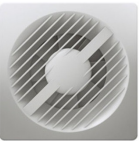
The ‘traditional’ look of a fan with a grille with slots to let the air through – nothing too complicated. It is a look we are all familiar with and millions of these are sold in the UK each year. So if you don’t want anything too fussy and want a fan for a traditional job then click here.
Discreet Fans

This traditional look has however been superseded by the introduction of ‘Discreet’ looking fans. These have a neutral (almost always white) cover which is flat or slightly curved and so neutralises the view of the fan. The air is sucked in around the edges and this has the advantage of not only reducing the impact of the appearance but also, with the flatter surface, making it easier to clean. Click here for a link to our Discreet Range
Designer Fans
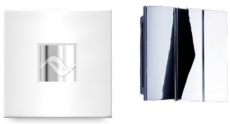
Designer fans are just about as opposite to discreet as you would want. Instead of minimalizing their look, they have instead been designed with chrome so that they make a feature of the unit. There are a number of choices so if you are OK with a bit more presence, then click here.
- Long Duct Runs. If you have a long duct run (3 metres or more) then this is for you Centrifugal
Generally, most domestic fans have axial blade impellers which are the type you will see located in most bathrooms and toilets in walls and in some ceiling installations.
However, axial blade fans have their limitations as they are really only suitable for installations up to 3 metres in a straight run, or 2 - 2.5 metres with a 90 degree bend. Once you get beyond this, greater consideration is required as the pressure the fan needs to move air a greater distance increases. Also, if you need to duct to an external wall which has a lot of wind and ventilating a room that gets steamy or the duct runs vertically and through a roof vent creating higher pressure, even with less than 3 metres of ducting you may wish to consider using a more powerful fan to ensure good ventilation.
In conclusion longer duct runs create more pressure. If you can imagine blowing down a half metre piece of hosepipe it’s easy. Compare this to doing the same with a 3 metre piece - obviously it will take more ‘puff’. If you then add 2 X 90 degree bends yet more ‘puff’ still is required (like when a fan is in a ceiling location – often 3 mtrs of ducting and 2 x 90 degree bends). So if you have a long duct run you need more ‘puff’ and this is when you should use a High Performance fan (known in the trade as centrifugal or mixed flow impeller fans).
High performance fans are designed to move air effectively over longer duct runs, they don’t run out of puff. They work when traditional fans don’t. Below are links to 3 of our products which give a mix of options if you need a High Performance fan
High Performance fans
UP TO 6 METRES Continuous Running Unity CV2GIP
UP TO 6 METRES Intermittent or Continuous running OF100GIP
UP TO 10 METRES Intermittent or Continuous running SF90
The figures above are conservative. It is possible to duct greater lengths without issue but these distances work in just about all installations.
- Humidity Controls. If you’re thinking of buying a Humidstat controlled fan then this is for you - Humidistat
How do they work?
Humidstat fans have a sensor in them which absorbs moisture from the air stream of the fan. The sensor detects when moisture levels rise to a set level and at this point the fan is either switched ‘on’ or to higher ‘boost’ speed when the pre-set moisture threshold is reached. The problem with this is that in the UK normal background levels of humidity vary between 30% - 90% from summer to winter – a 60% difference. So, if your fan is set to activate to come on or to boost at any point between 30 – 90% it can activate when you may not want it to – i.e. a humid summers night when you are sleeping, or, conversely, will not activate when you want it too.
The problem described above occurs with traditional basic humidity sensing controls. These have been used for many years and are the most common feature in the majority of humidty sensing fans sold today. These can be good but lack the ability to be able to be controlled ‘intelligently’ with modern ‘smart’ technology. Alternative technology is available which uses modern sensing which, unlike standard fans, do not have a fixed point for on/off and work by constantly measuring the natural humidity level of your room and not react. The fan notices these natural variations and it does not react. Instead, the fan is programmed to detect man-made spikes in humidity caused by showering, bathing or cooking and only then increase to boost speed.
Greenwood have developed this technology and have registered the name HumidiSMART®. So if you want to make sure that ventilation is delivered (to help prevent mould and mildew and keep the room fresh) only when it is absolutely needed –and not when you don’t, look for the HumidiSmart name on the product details. Sweet dreams zzzzzzzzzzzzzzzzz.
- Mustiness. A musty room is causing an issue, then this is for you - Constant Running
Constant running fans have been around for years but are becoming more prevalent as changes to house building, regulation and the increase in home insulation have all conspired to reduce the amount of natural ventilation (air leakage) that occurs in our homes. This is of course intended but a side effect of wrapping our houses up so they stay warm is that they don’t ‘breathe’ like they used to.
In 2004, the number of air changes per hour you could expect to occur in a property was 16.9. Today, that figure is below 4 so the level of natural ventilation has decreased dramatically. Whilst the majority of fans sold are for the refurbishment market, and a lot of houses are still ‘leaky’, the point is clear that as houses are wrapped up tighter, then there will also be a corresponding decrease in natural ventilation. Ultimately, this leads to a situation whereby moist air is trapped in buildings which becomes stale and as a consequence there is a rise in mould and condensation issues. The potential for problems to occur are made clearer when it is estimated that just taking a bath or shower can release as much as 2 pints of moisture into a room.
Because of this reduction in uncontrolled natural air leakage, the use of controlled continuous ventilation has increased. As opposed to traditional intermittent ventilation which is designed to operate on a high speed when the room is in use, continuous running fans, as the name suggest, run for 24 hours a day 365 days a year. The principle used is that for the majority time when the room is unoccupied, the fan will run on a low background speed and boost to a higher speed when the room is in use - as with intermittent ventilation. The point of this is that the low level continuous running helps replace some the traditional background ventilation that no longer occurs due to ‘tighter’ house builds and increased insulation keeping the room fresh.
There are two issues to consider with this approach – one is that of noise and the other is that of energy use. Generally, the sound of the fan is not an issue as they are designed to run on a very low speed for the majority of the time and so the sound of the fan is also very low. To explain this, when running on low speed (5 litres per second in line with Building Regulations) they make just 10.1d(B)A. which is about the sound level you can hear when leaves rustle. For a further explanation of d(B)A and silence please click here. As for energy use, our continuous running fans use modern DC motors which not only help limit the sound of the motor running but also help with energy efficiency. As an example, our bestselling continuous running product – CV2GIP - when used 24hours /day365 days/year, will only cost about £1.50 per year (Yes, that’s £0.03p per week) to run.
So if you have recently refurbished or insulated your home, have a bathroom, shower or en-suite with no windows, a problem room which is perennially musty and suffers from condensation or just gets a lot of use, then continuous ventilation is something which you should consider.
Please click here to see our continuous running fan section.
ELECTRICAL SAFETY (SELV) If you are concerned about electrical safety and need to understand SELV and Zone 1 Bathroom fans then this is for you. - Low Voltage
Low voltage (as opposed to low energy) relates to safety. As a person is often barefoot or unclothed in a wet room environment, this is an area in which reduced protection normally provided by clothing from electrical shock occurs. Add to this the presence of water and the bathroom becomes an area of increased risk of electrical shock.
In fact, the bathroom is classed as a ‘special location’ under Part P of the Building Regulations which means that other than for ‘like for like’ replacement of existing electrical equipment, just about all other items will be classed as ‘Notifiable Work’. In order to comply with this requirement, Notifiable Work will need to be carried out by a person who has received assessment and is a member of one of a number of part P competent persons schemes.
As the bathroom is considered a ‘special location’ safety is paramount and so, bath, shower and wet rooms are divided into zones for electrical purposes which the diagram below details.
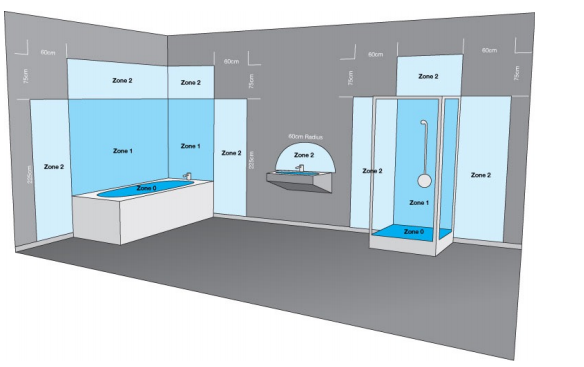
As you can see, there are 3 Zones - 0, 1 & 2 plus outside of this is an area called the Outside Zone and electrical equipment is categorised as to whether it is suitable for use in the relevant zones of the bathroom.
For fans, the regulations state that should it (or other electrical appliances) be fitted within Zone 1 of the bathroom then a Safety (or Separated) Extra- Low Voltage or SELV fan should be fitted as these, as the name suggests, are designed to operate with reduced voltage and so increase the safety element for the user. Irrespective of this, some people chose to use a SELV fan in any bathroom situation as a matter of personal preference.
Generally, this is done by having a fan which works the same way as usual but in addition, a transformer is included and this is placed outside the wet room zones. The transformer then supplies power to the fan at a reduced voltage to provide additional safety to the occupant. A typical example of a SELV fan with a transformer is shown below

To see the full range of SELV fans available please click here
- LOW ENERGY FANS Looking for a Low Energy fan, then this is for you - Low Energy
There is no strict definition as to what comprises a Low Energy fan and so various manufacturers have attached different definitions to the term. Below, is a quick overview of the situation which will hopefully clarify things a little.
Traditional bathroom fans consume 15 – 25 watts of electricity. These generally use AC motors which tend to be less efficient than their more contemporary alternatives. As the focus has shifted towards reducing energy consumption as part of the Green movement, so new technology has been adopted to run more efficiently and lessen electrical consumption. This is where the appeal of Low Energy fans has arisen and new products developed also, they generally run quieter.
All fans categorised by Epicair as ‘Low Energy’ incorporate modern DC motors and are designed to run at a minimum of 1.1 watts and a maximum of 9 watts which provides a substantial reduction in energy use vs. their traditional counterparts. To try and put this into perspective, this means that a Low Energy intermittent fan, used at an average of 2 hours per day, will cost somewhere between £0.12 - £0.99p a year to run. This when compared to standard fans that typically use 2 or 3 times the energy represents a significant saving of energy. But what does it mean? Well, realistically it should make a saving of c.£2.00 per year. Yes, we appreciate it’s not a going to go too far towards that once in a lifetime holiday but, it does save energy, it’s enough to buy a Lottery ticket and after that, who knows what could happen.
Note;The above figures are based on an average of 2hours daily use with 1Kw of energy costing £0.15p
If you’re happy with this and don’t want to get a bit technical you can stop reading here and click the link below to visit our low energy fan page. If you don’t mind getting a bit technical, read on.
One of the key problems with traditional AC technology is that whilst they can be made to be ‘Low Energy’, they pay a price in terms of reduced performance. What this means is that the energy use is low but their ability to move air efficiently and handle pressure is equally low. In order to assess this, a measure of fan performance is used called Specific Fan Power or SFP. The calculation of this is watts/litres per second = SFP. It is also described in Wikipedia as ‘Specific Fan Power (SFP) is a parameter that quantifies the energy-efficiency of fan air movement systems. It is a measure of the electric power that is needed to drive a fan (or collection of fans), relative to the amount of air that is circulated through the fan(s). It is not constant for a given fan, but changes with both air flow rate and fan pressure rise.’
This is a bit technical but important and Part F of the Building Regulations 2010 require an intermittent bathroom fan or intermittent toilet fan to be able to achieve flow rates of :
WC - 6 litres per second
Bathroom - 8 litres per second
Utility Room - 30 litres per second
Kitchen - 60 litres per second
respectively when installed.
In addition, best practice taken from HM Government Domestic Building Services Compliance Guide stipulates that the SFP at the above flow rates should not be worse than 0.5 W/(l/s) (watts per litre per second). If you are still with us, then to simplify things again, what we can state is that all Epicair low energy fans will meet the above requirement.
WINDOW FITTING Need a window fan – this is for you - Window
Fan installation in windows is a common feature and there are a number of things to bear in mind. Below is a quick overview of features and things to consider when deciding on the right approach for you.
There are 6 fans in our range which have the option of being fitted into a window – 3 Standard and 3 Low Energy.
Standard – traditional AC motor fans with window kit options.
• Elite 100mm and SF90 Bathroom fans (centrifugal for long duct runs)
• Elite 150mm Kitchen fan
• Elite - shutter system on fan removes the needs for shutters on the window kit• Requires a glazing hole of either 108 or 118mm – check model
• Can be fitted in single or double glazing of 4mm – 28mm
• These are made of plastic which is UV stabilised to protect from the effects of the Sun.
Low Energy – these are the latest fan models with modern low energy DC motors complimented by new window kits designed with the most modern techniques to provide additional features
• Omnique OF 100 _ kitchen or bathroom - for long duct runs, Samika LE100 bathroom 118mm glazing hole - for a video of the Omnique window kit please click here.
• LE150 Kitchen fan – 167 mm glazing hole
• Increased security – designed in conjunction with leading housing providers to ensure that areas of intruder risk are removed
• Robust material – manufactured from polycarbonate – the same as used for making hard hats so it has durability and core strength
• Soft close shutters – Samika – added features to reduce noise caused by opening/ closing of the shutters and prevent draughts
• Silent shutters – Omnique – shutter system on fan removes the needs for shutters on the window kit, are 100% silent and also prevents heat loss and draughts
• Privacy – designed to remove the possibility for external viewing into the room
SHOWER FAN - If you need a shower fan then this is for you - Shower
Due to bathrooms being classified as areas of increased electrical hazard, products that are installed in them are subject to additional regulation. This is done in two ways:
1. The bathroom is divided into a series of Zones - which are assessed depending on the proximity of water, electricity and people to each other – see diagram below
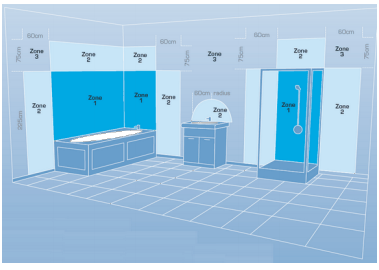
2. Products to be fitted into a bathroom are assessed for safety to see which Zone that are suited – see below

As shower fans are generally fitted within Zone 1 the regulations require that any fan sited in this Zone should have a minimum rating of IPX4(IP44) and, if there is a likelihood of water jets being used for cleaning purposes, a minimum of IPX5 is required. Whilst this is the minimum, SELV (Safety Extra Low Voltage fans are often used for increased peace of mind and we have a range of SELV products some which can be used if required.
Additionally, we also have a range of bathroom shower kits which have been designed to work with up to 3 metres of ducting. The choice available is extensive and includes;
Silent Duct fan (100mm)
Silent fan shower kit (100mm)
Silent fan shower kit with light (100mm)
High performance shower kit (115mm)
High performance shower kit with light (115mm)
PLEASE CLICK HERE FOR DETAILS OF OUR BATHROOM SHOWER PRODUCTS
The AXS100 and the EL100 ranges - Standard
Almost all fans you will see installed today are ‘standard or traditional’. By this we mean they are designed and manufactured using traditional components i.e. ac motors and standard analogue controls. As with everything, there are good and bad of these. Ours are good and will do the job they are designed for. The only thing you will find is a little more noise (the motors are traditional) and less control (the speed setting is fixed and the controls are less adjustable). Other than that, if you want a fan to do a job, the way fans have always done them, then this is for you. In fact, if you want a fan which will do a really good job and keep the wind out with a set of silent (yes, that’s no noise, shutters) then have a look at the Elite EL100 Range. Elite has shutters which open and close tight so there is no ‘clickety clack’ with the wind.
Kitchens and Utility Rooms
Modern kitchen ventilation is achieved using a cooker hood, however on occasion extra ventilation is required. Building regulations stipulate that you need a fan with a high extract rate in kitchens. While most bathroom fans have a 100mm spigot (the diameter of the air outlet on the back), kitchen fans tend to have a 150mm diameter spigot.
Fans can vent to the outside world in one of three ways - wall, window or ceiling. Not all fans can be mounted in all ways so it is always best to check which solution is best for your circumstances. Our range of Kitchen extractor fans can be found on the Epicair website
Kitchen Cooker Hoods
Quick Product Overview
There are 4 main areas for Cooker hoods:
Wall Mounted – Feature hoods for modern kitchens
Chimney – Traditional and Modern Chimney styles
Integrated - Used for installations under kitchen cabinets and alcoves
Island – Ideal for central cooking areas in the kitchen
Standard Kitchen Fans - Traditional fans used in small kitchens and Utility rooms
Window – Kitchen Window fans
Choosing the correct Cooker Hood
Choosing the correct airflow Power
The airflow power (expressed in m3/hr) required normally depends on the size of kitchen and type of cooking. The Epicair website shows the airflow performance of each cooker hood by simply clicking on the additional information tab when you’re at your chosen product, see pics below
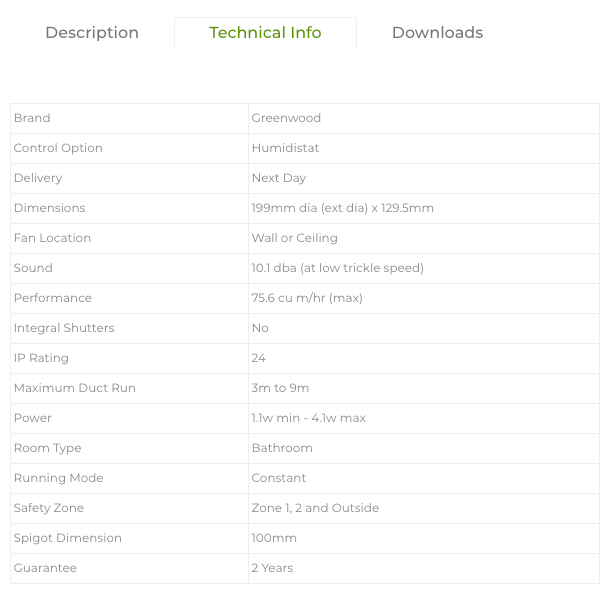
For comparison purposes free air flow should be reduced by 10 -15% to arrive at an approximation for the ieC airflow. The minimum appropriate airflow power for a kitchen can be estimated by multiplying the volume of the kitchen by 10.
For example, a kitchen of 3m x 4m with a height of 2.7m would require a cooker hood with a maximum airflow of at least 324 m3/hr (3 x 4 x 2.7 x 10). The amount of cooking being done at any one time is also important, if you usually cook just one item at a time then a model with a performance of up to 300-400 m3/h should be sufficient, if you cook 2 or 3 items at a time we recommend a model with an airflow capacity of at least 400-500 m3/h and if you cook 4 or more items at a time then the airflow should be over 700m3/hr effective capture of cooking fumes also depends on the correct installation and operation of the product
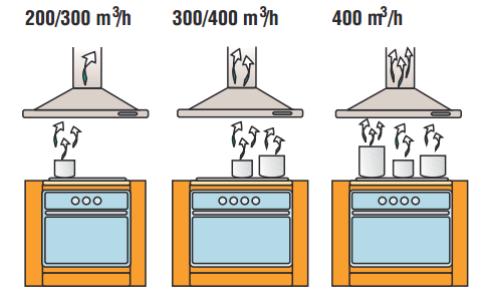
Air Filtration types
There are two distinct types of filtration. As air is drawn through the cooker hood it first passes through a grease filter which removes the heaviest grease particles from the air, protecting the interior of the product. Some grease filters are made of a synthetic, fibrous material and these need to be replaced regularly but most Elica hoods use more effective and long lasting aluminium mesh filters which can be washed by hand or in a dishwasher. The second type of filtration - principally odour filtration - is only present when a hood is installed in re-circulating mode, this uses an active carbon filter to capture odours and residual grease. Whilst the conventional carbon filter must in general be replaced every 3-4 months, Elica has developed a high performance long life filter which can be “regenerated” by washing in a dishwasher and then drying in an oven for ten minutes at 100°C. Follow this procedure and the Elica long life Filter will work effectively for up to 3 years.
Choosing the right mode – Duct-out or Re-Circulating
With specific exceptions, almost all All Elica cooker hoods can be installed to work in either duct-out mode, where air is expelled to the outside through ducting, or recirculating mode, where air is purified through filters and returned to the kitchen. Both modes ensure cleaning of the kitchen air, however the duct-out mode will always be more effective. This mode may require an additional external chimney which will affect the aesthetics, particularly of hanging models. Ducting must be the correct diameter (usually 150 mm) and should not be too long or with too many bends. the exact relationship between ducting and airflow is complicated but we have a wide range of types of ducting available and can offer advice to your designer on what would work best. No ducting is required outside of the hood itself when it is installed in re-circulating mode but correct maintenance of the odour filters and their replacement when necessary is extremely important.
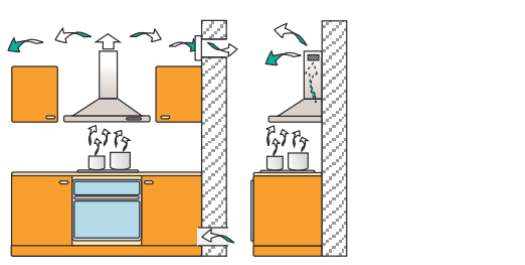
Correct installation
Correct installation is important to ensure that the hood works at its best. All the steps described in the product’s instruction booklet must be carefully followed and in particular, make sure to have the correct minimum distance between the hob and the cooker hood for your own safety in order to avoid damage to your cooker hood. This is set out in the instruction and installation book and will depend on the type of hob that you have.
Operation
Switch the hood on at low speed when you start cooking then, as fumes and odours increase, the airflow power should be increased. When cooking is finished, return to low speed and keep the hood on for a further 5-10 min. some elica hoods have automatic functions to keep the kitchen air clean and timers to continue running after they are turned off.






